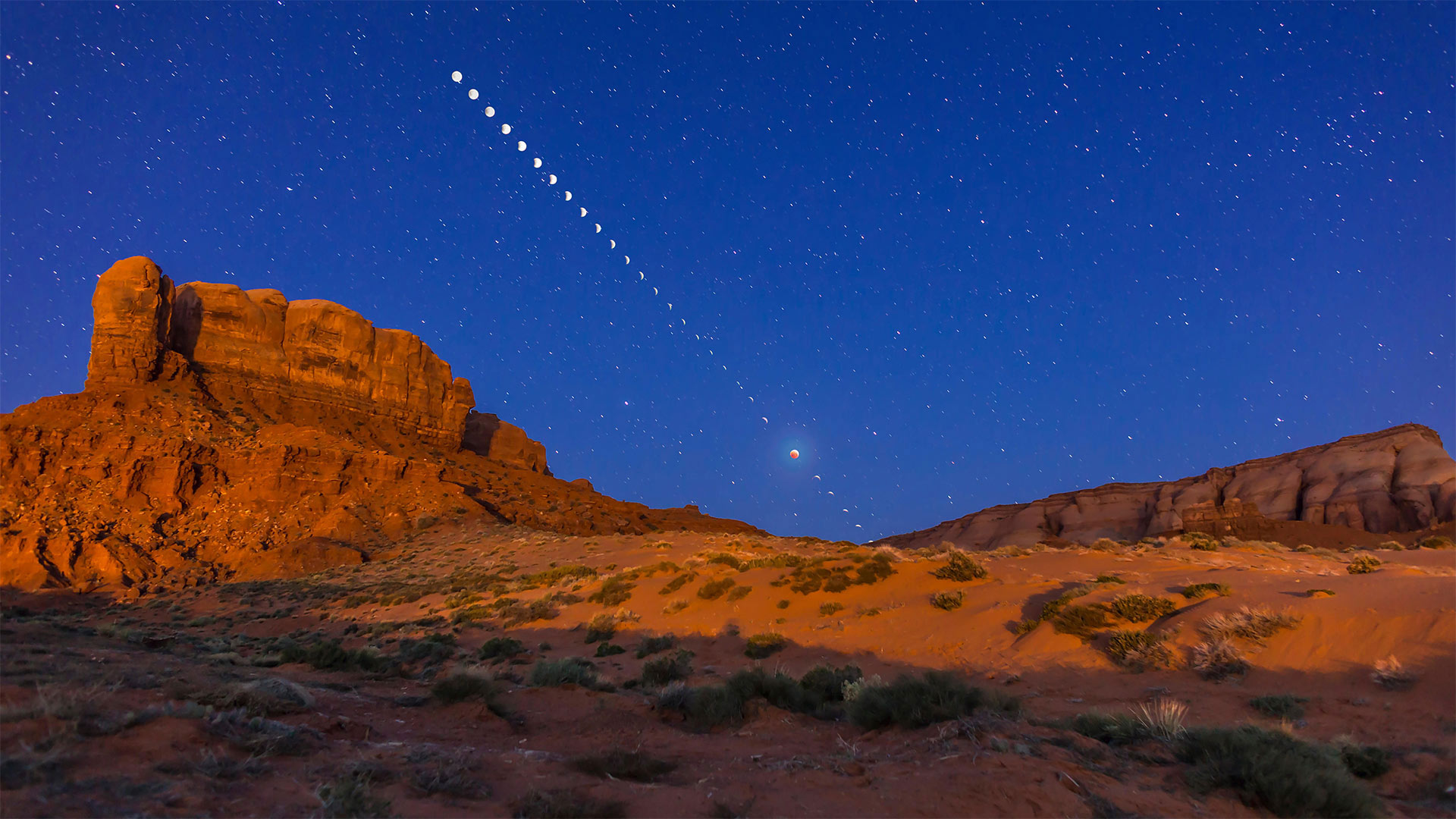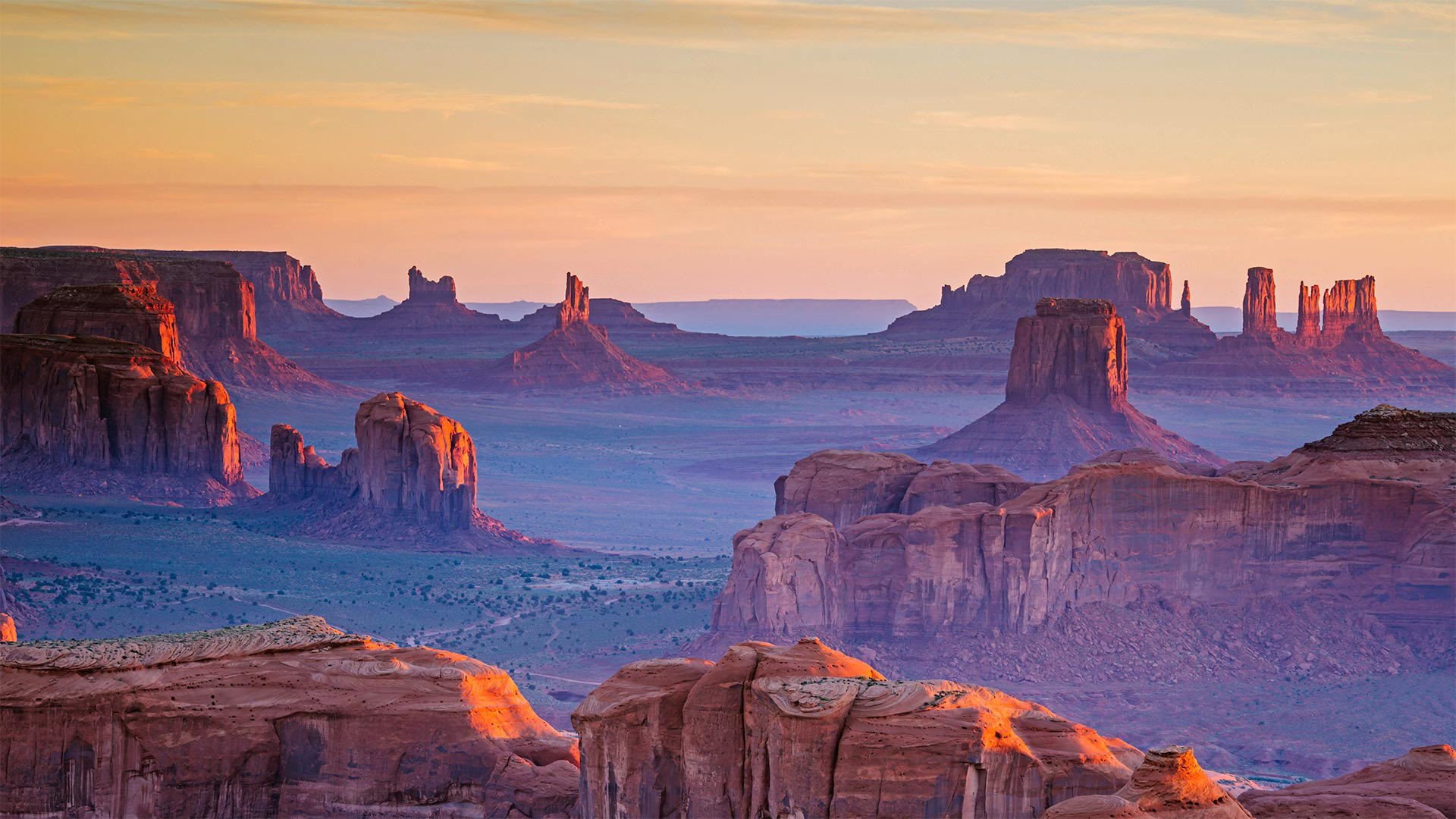2015年4月4日摄于Tear Drop Arch附近的月全食,犹他州纪念碑谷 The total lunar eclipse of April 4, 2015, taken from near Tear Drop Arch, in western Monument Valley, Utah (© Alan Dyer/Alamy)

2015年4月4日摄于Tear Drop Arch附近的月全食,犹他州纪念碑谷 The total lunar eclipse of April 4, 2015, taken from near Tear Drop Arch, in western Monument Valley, Utah (© Alan Dyer/Alamy)
Behold the blood moon
We've heard the phrase 'many moons,' but never took it this literally. We're looking at 28 merged photos of our one and only moon over Utah's Monument Valley: 26 snapshots of its partial phases, plus two layered exposures of the eclipsing moon at center.
If the weather's agreeable tonight, folks in the US and many other parts of the world are in for a total 14-minute eclipse of the full moon similar to this one from 2015. The lunar eclipse is sometimes called a blood moon for the crimson shadow Earth casts on the lunar surface, and tonight's show carries a little extra gravity: The eclipse will occur as the moon takes its closest pass to Earth this year, making it appear large in the sky and giving it the ominous title of Super Blood Moon.
看血月
我们听过“许多月亮”这句话,但从来没有这样的字面意思。我们正在看28张合并后的照片,这是犹他州纪念碑谷上空我们唯一的一个月亮:26张部分相位的快照,加上两层日食月亮的中心曝光。
如果今晚天气宜人,美国和世界其他许多地方的人们将迎来一次14分钟的满月全食,与2015年的这次月食相似。月食有时被称为血月,因为地球在月球表面投下了深红色的阴影,今晚的节目还有一点额外的引力:今年月亮离地球最近的时候会发生月食,使它在天空中显得很大,并给它一个不祥的称号“超级血月”。
从亨茨梅萨俯瞰纪念碑谷,亚利桑那州与犹他州之间纳瓦霍族保留地 A view of Monument Valley Navajo Tribal Park from Hunts Mesa, Navajo Nation, between Arizona and Utah (© AWL Images/Danita Delimont)

从亨茨梅萨俯瞰纪念碑谷,亚利桑那州与犹他州之间纳瓦霍族保留地 A view of Monument Valley Navajo Tribal Park from Hunts Mesa, Navajo Nation, between Arizona and Utah (© AWL Images/Danita Delimont)
A monumental view of 'Tsé Biiʼ Ndzisgaii'
This expansive and iconic view, taken from Hunts Mesa in the Navajo Nation, is none other than Monument Valley, also known as the Valley of the Rocks when translated from the Navajo language (Tsé Biiʼ Ndzisgaii). The red sandstone formations are synonymous with the American Southwest and have stunned moviegoers for nearly a century. The largest of American Indian territories, Navajo Nation covers more than 27,000 square miles and reaches into portions of Arizona, Utah, and New Mexico.
During World War II, an elite team of Navajos left their homes to join the US Marine Corps and solve a communications challenge. In the Pacific, many of the US combat codes had been cracked by the Japanese army and navy, leaving US troops vulnerable to attack by Axis forces. But in 1942, the first 29 Navajo recruits helped develop a new undecipherable code. They used common words and phrases from their tribal language to convey some messages and created special codes to describe military terms; for instance, various weapons of war were assigned Navajo bird names. Code Talkers could encode, send, and decode a three-line English message text—without error—in roughly 20 to 150 seconds. It took machines of the day at least 30 minutes, sometimes longer, to do the same thing.
Some say the US would not have prevailed at the fiercely fought Battle of Iwo Jima had it not been for the Navajo Code Talkers' contributions. And yet, their contributions would go unknown until the program was finally declassified in 1968. Navajo Code Talkers Day was established on August 14, 1982 to commemorate the elite team as well as other Native Americans and First Nations people who had developed codes used in other conflicts. It's a fascinating history that you can learn more about by taking our quiz.